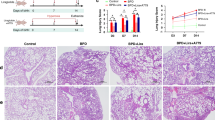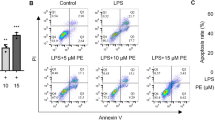Abstract
Background:
Heterozygous ATP-binding-cassette subfamily A member 3 (ABCA3) mutations are associated with neonatal respiratory complications. In an adult murine model, we investigated whether Abca3 haploinsufficiency is a predisposing factor for lung injury induced by hyperoxia or mechanical ventilation.
Methods:
Abca3 haploinsufficient (Abca3+/−) and wild-type (WT) mice were prospectively randomized to 25 min of ventilation or 72 h of hyperoxia or left unchallenged in air.
Results:
As compared with WT mice, unchallenged Abca3+/− mice had significantly decreased lung phosphatidylcholine (PC) and phosphatidylglycerol (PG) levels (P < 0.02) and decreased lung compliance (P < 0.05). When ventilated for 25 min, Abca3+/− mice demonstrated a significantly greater increase in bronchoalveolar lavage (BAL) interleukins (P ≤ 0.01) and lung wet to dry ratio (P < 0.005). Hyperoxia resulted in increased compliance (P < 0.05) and total lung capacity (TLC) (P = 0.01) only in the Abca3+/− mice, consistent with enlarged alveolar spaces. The ratio of PC to PG in BAL—relevant for surfactant dysfunction—was significantly elevated by oxygen exposure, with the greatest increase in Abca3+/− mice.
Conclusion:
In a murine model, Abca3 haploinsufficiency results in an altered biochemical and lung mechanical phenotype, as well as a greater lung injury induced by hyperoxia or mechanical ventilation. The inability to maintain a normal PC/PG ratio appears to play a key role.
Similar content being viewed by others
Log in or create a free account to read this content
Gain free access to this article, as well as selected content from this journal and more on nature.com
or
References
Yamano G, Funahashi H, Kawanami O, et al. ABCA3 is a lamellar body membrane protein in human lung alveolar type II cells. FEBS Lett 2001;508:221–5.
Garmany TH, Moxley MA, White FV, et al. Surfactant composition and function in patients with ABCA3 mutations. Pediatr Res 2006;59:801–5.
Shulenin S, Nogee LM, Annilo T, Wert SE, Whitsett JA, Dean M . ABCA3 gene mutations in newborns with fatal surfactant deficiency. N Engl J Med 2004;350:1296–303.
Bullard JE, Wert SE, Whitsett JA, Dean M, Nogee LM . ABCA3 mutations associated with pediatric interstitial lung disease. Am J Respir Crit Care Med 2005;172:1026–31.
Karjalainen MK, Haataja R, Hallman M . Haplotype analysis of ABCA3: association with respiratory distress in very premature infants. Ann Med 2008;40:56–65.
Garmany TH, Wambach JA, Heins HB, et al. Population and disease-based prevalence of the common mutations associated with surfactant deficiency. Pediatr Res 2008;63:645–9.
Hamvas A, Cole FS, Nogee LM . Genetic disorders of surfactant proteins. Neonatology 2007;91:311–7.
Bækvad-Hansen M, Nordestgaard BG, Dahl M . Heterozygosity for E292V in ABCA3, lung function and COPD in 64,000 individuals. Respir Res 2012;13:67.
Wambach JA, Wegner DJ, Depass K, et al. Single ABCA3 mutations increase risk for neonatal respiratory distress syndrome. Pediatrics 2012;130:e1575–82.
Hammel M, Michel G, Hoefer C, et al. Targeted inactivation of the murine Abca3 gene leads to respiratory failure in newborns with defective lamellar bodies. Biochem Biophys Res Commun 2007;359:947–51.
Fitzgerald ML, Xavier R, Haley KJ, et al. ABCA3 inactivation in mice causes respiratory failure, loss of pulmonary surfactant, and depletion of lung phosphatidylglycerol. J Lipid Res 2007;48:621–32.
Cheong N, Zhang H, Madesh M, et al. ABCA3 is critical for lamellar body biogenesis in vivo. J Biol Chem 2007;282:23811–7.
Tokieda K, Iwamoto HS, Bachurski C, et al. Surfactant protein-B-deficient mice are susceptible to hyperoxic lung injury. Am J Respir Cell Mol Biol 1999;21:463–72.
Smith LJ . Hyperoxic lung injury: biochemical, cellular, and morphologic characterization in the mouse. J Lab Clin Med 1985;106:269–78.
Crapo JD . Morphologic changes in pulmonary oxygen toxicity. Annu Rev Physiol 1986;48:721–31.
dos Santos CC, Slutsky AS . The contribution of biophysical lung injury to the development of biotrauma. Annu Rev Physiol 2006;68:585–618.
Veldhuizen EJ, Haagsman HP . Role of pulmonary surfactant components in surface film formation and dynamics. Biochim Biophys Acta 2000;1467:255–70.
Hite RD, Seeds MC, Bowton DL, et al. Surfactant phospholipid changes after antigen challenge: a role for phosphatidylglycerol in dysfunction. Am J Physiol Lung Cell Mol Physiol 2005;288:L610–7.
Tschumperlin DJ, Drazen JM . Chronic effects of mechanical force on airways. Annu Rev Physiol 2006;68:563–83.
Zemans RL, Matthay MA . Bench-to-bedside review: the role of the alveolar epithelium in the resolution of pulmonary edema in acute lung injury. Crit Care 2004;8:469–77.
Besnard V, Matsuzaki Y, Clark J, et al. Conditional deletion of Abca3 in alveolar type II cells alters surfactant homeostasis in newborn and adult mice. Am J Physiol Lung Cell Mol Physiol 2010;298:L646–59.
Riley DJ, Kramer MJ, Kerr JS, Chae CU, Yu SY, Berg RA . Damage and repair of lung connective tissue in rats exposed to toxic levels of oxygen. Am Rev Respir Dis 1987;135:441–7.
Xu Y, Saegusa C, Schehr A, Grant S, Whitsett JA, Ikegami M . C/EBP{alpha} is required for pulmonary cytoprotection during hyperoxia. Am J Physiol Lung Cell Mol Physiol 2009;297:L286–98.
Brasch F, Schimanski S, Mühlfeld C, et al. Alteration of the pulmonary surfactant system in full-term infants with hereditary ABCA3 deficiency. Am J Respir Crit Care Med 2006;174:571–80.
Bullard JE, Nogee LM . Heterozygosity for ABCA3 mutations modifies the severity of lung disease associated with a surfactant protein C gene (SFTPC) mutation. Pediatr Res 2007;62:176–9.
Mahavadi P, Korfei M, Henneke I, et al. Epithelial stress and apoptosis underlie Hermansky-Pudlak syndrome-associated interstitial pneumonia. Am J Respir Crit Care Med 2010;182:207–19.
Liebisch G, Lieser B, Rathenberg J, Drobnik W, Schmitz G . High-throughput quantification of phosphatidylcholine and sphingomyelin by electrospray ionization tandem mass spectrometry coupled with isotope correction algorithm. Biochim Biophys Acta 2004;1686:108–17.
Leidl K, Liebisch G, Richter D, Schmitz G . Mass spectrometric analysis of lipid species of human circulating blood cells. Biochim Biophys Acta 2008;1781:655–64.
Brügger B, Erben G, Sandhoff R, Wieland FT, Lehmann WD . Quantitative analysis of biological membrane lipids at the low picomole level by nano-electrospray ionization tandem mass spectrometry. Proc Natl Acad Sci USA 1997;94:2339–44.
Matyash V, Liebisch G, Kurzchalia TV, Shevchenko A, Schwudke D . Lipid extraction by methyl-tert-butyl ether for high-throughput lipidomics. J Lipid Res 2008;49:1137–46.
Flemmer AW, Jani JC, Bergmann F, et al. Lung tissue mechanics predict lung hypoplasia in a rabbit model for congenital diaphragmatic hernia. Pediatr Pulmonol 2007;42:505–12.
Lovgren AK, Jania LA, Hartney JM, et al. COX-2-derived prostacyclin protects against bleomycin-induced pulmonary fibrosis. Am J Physiol Lung Cell Mol Physiol 2006;291:L144–56.
Bates JH . Understanding lung tissue mechanics in terms of mathematical models. Monaldi Arch Chest Dis 1993;48:134–9.
Hantos Z, Daróczy B, Suki B, Nagy S, Fredberg JJ . Input impedance and peripheral inhomogeneity of dog lungs. J Appl Physiol 1992;72:168–78.
Author information
Authors and Affiliations
Corresponding author
Supplementary information
Supplementary Figure S1.
(JPEG 160 kb)
Rights and permissions
About this article
Cite this article
Herber-Jonat, S., Mittal, R., Huppmann, M. et al. Abca3 haploinsufficiency is a risk factor for lung injury induced by hyperoxia or mechanical ventilation in a murine model. Pediatr Res 74, 384–392 (2013). https://doi.org/10.1038/pr.2013.127
Received:
Accepted:
Published:
Issue date:
DOI: https://doi.org/10.1038/pr.2013.127



